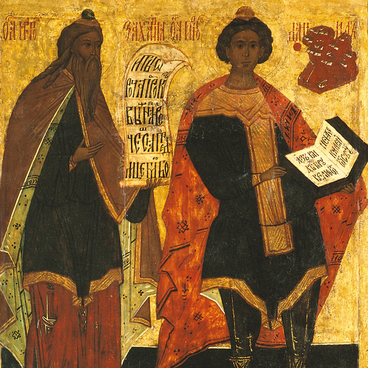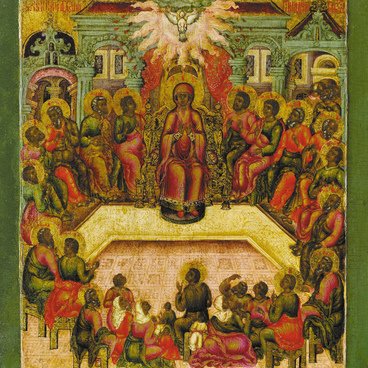The Annunciation of Our Lady, earlier known as the Annunciation of the Lord, is one of the oldest Christian celebrations which the Church Fathers, including, among others, John Chrysostom, Gregory of Neocaesarea, Athanasius of Alexandria, Jerome, and Augustine, described in their teachings in the 3rd and 4th centuries. The canons appeared in the 8th century with the help of John of Damascus and Theophanes, Bishop of Nicaea.
According to Luke the Evangelist, six months after Elisabeth conceived her son, who would become John the Baptist, the angel Gabriel was sent from God to the Virgin Mary to announce to her that she would soon become the mother of the Savior.
In his commentaries to the Bible, the Byzantine scholar Theophylact of Ohrid identifies similarities between the words describing the curse of Eve (“in sorrow thou shalt bring forth children” (Genesis 3:16)) and the blessing of Mary. Therefore, the words “Hail, thou that art highly favored” represent glad tidings of joy not only for Mary but also for all humanity since the fall of man.
The iconography of this story started taking shape rather early, in the 2nd century (with the first icons found in the catacombs of Rome), and was finally formed in the Middle Ages. As a rule, since the 6th or 7th century, Mary was usually placed on the right side of the painting, and there was some object between her and the archangel Gabriel, such as a column, a white lily, or a candle. It aimed to emphasize the spirituality of their dialogue.
The archangel found the Virgin Mary performing a sacred task — weaving the veil for the Temple in Jerusalem. The red thread on the spinning wheel is usually interpreted not only as a reminder of the sacred work of the Virgin Mary but also as a symbol of creating Christ’s flesh.
Instead of the carpenter’s house in Nazareth, the background usually depicted the New Jerusalem with walls built of gold, a temple looking like a palace, and an altar that is also a throne. This image was used to venerate Virgin Mary as the God-Bearing Human Temple which carries God within. At the feet of Mary is a serving maid spinning. Although experts have not reached a conclusion as to the meaning of this image, it may be related to the ancient concept of spinning the threads of a new life. According to old legends, spinners appeared by the bed of women in childbirth. In this case, the allegory also refers to the Incarnation that took place at the moment of the Annunciation.
This icon belonged to the feasts tier of the iconostasis of the Transfiguration Monastery in Yaroslavl. It included the icons dedicated to the main Orthodox feasts, most importantly, the great feasts, or the twelve dates venerated by the Church and considered to be the most significant holy days.
According to Luke the Evangelist, six months after Elisabeth conceived her son, who would become John the Baptist, the angel Gabriel was sent from God to the Virgin Mary to announce to her that she would soon become the mother of the Savior.
In his commentaries to the Bible, the Byzantine scholar Theophylact of Ohrid identifies similarities between the words describing the curse of Eve (“in sorrow thou shalt bring forth children” (Genesis 3:16)) and the blessing of Mary. Therefore, the words “Hail, thou that art highly favored” represent glad tidings of joy not only for Mary but also for all humanity since the fall of man.
The iconography of this story started taking shape rather early, in the 2nd century (with the first icons found in the catacombs of Rome), and was finally formed in the Middle Ages. As a rule, since the 6th or 7th century, Mary was usually placed on the right side of the painting, and there was some object between her and the archangel Gabriel, such as a column, a white lily, or a candle. It aimed to emphasize the spirituality of their dialogue.
The archangel found the Virgin Mary performing a sacred task — weaving the veil for the Temple in Jerusalem. The red thread on the spinning wheel is usually interpreted not only as a reminder of the sacred work of the Virgin Mary but also as a symbol of creating Christ’s flesh.
Instead of the carpenter’s house in Nazareth, the background usually depicted the New Jerusalem with walls built of gold, a temple looking like a palace, and an altar that is also a throne. This image was used to venerate Virgin Mary as the God-Bearing Human Temple which carries God within. At the feet of Mary is a serving maid spinning. Although experts have not reached a conclusion as to the meaning of this image, it may be related to the ancient concept of spinning the threads of a new life. According to old legends, spinners appeared by the bed of women in childbirth. In this case, the allegory also refers to the Incarnation that took place at the moment of the Annunciation.
This icon belonged to the feasts tier of the iconostasis of the Transfiguration Monastery in Yaroslavl. It included the icons dedicated to the main Orthodox feasts, most importantly, the great feasts, or the twelve dates venerated by the Church and considered to be the most significant holy days.




